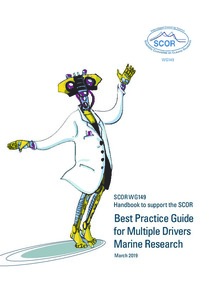| dc.contributor.author | Boyd, P.W. | |
| dc.contributor.author | Collins, S. | |
| dc.contributor.author | Dupont, S. | |
| dc.contributor.author | Fabricius, K. | |
| dc.contributor.author | Gattuso, J-P. | |
| dc.contributor.author | Havenhand, J. | |
| dc.contributor.author | Hutchins, D.A. | |
| dc.contributor.author | McGraw, C.M. | |
| dc.contributor.author | Riebesell, U. | |
| dc.contributor.author | Vichi, M. | |
| dc.contributor.author | Biswas, H. | |
| dc.contributor.author | Ciotti, A. | |
| dc.contributor.author | Dillingham, P. | |
| dc.contributor.author | Gao, K. | |
| dc.contributor.author | Gehlen, M. | |
| dc.contributor.author | Hurd, C.L. | |
| dc.contributor.author | Kurihawa, H. | |
| dc.contributor.author | Navarro, J. | |
| dc.contributor.author | Nilsson, G.E. | |
| dc.contributor.author | Passow, U. | |
| dc.contributor.author | Portner, H-O. | |
| dc.date.accessioned | 2019-05-16T21:46:09Z | |
| dc.date.available | 2019-05-16T21:46:09Z | |
| dc.date.issued | 2019 | |
| dc.identifier.citation | Boyd, P.W.; Collins, S.; Dupont, S.; Fabricius, K.; Gattuso, J-P.; Havenhand, J.; Hutchins, D,A.; McGraw, C.M.;
Riebesell, U.; Vichi, M.; Biswas, H.; Ciotti, A.; Dillingham, P.; Gao, K.; Gehlen, M.; Hurd, C.L,; Kurihawa, H.;
Navarro, J,; Nilsson, G.E.; Passow, U. and Portner, H-O. (2019) SCOR WG149 Handbook to support the SCOR
Best Practice Guide for Multiple Drivers Marine Research. Hobart, Tasmania, University of Tasmania for Scientific Committee on Oceanic Research (SCOR), 42pp. DOI:http://dx.doi.org/10.25959/5c92fdf0d3c7a | en_US |
| dc.identifier.uri | http://hdl.handle.net/11329/934 | |
| dc.identifier.uri | http://dx.doi.org/10.25607/OBP-475 | |
| dc.description.abstract | Marine species and ecosystems are exposed to a wide
range of environmental change – both detrimental
(threats) and beneficial – due to human activities.
Some of the changes are global, whereas others
are regional or local. It is important to distinguish
the scale of each threat as the solutions will differ.
For example, the mitigation of a global problem
requires a global response, which is more difficult
to achieve than addressing a local problem with
a local response. These wide-ranging changes
are often referred to drivers or stressors. The term multiple drivers refers to the concurrent
alteration of multiple environmental properties, that
are each biologically-influential, by anthropogenic
pressures including climate change. These multiple
environmental properties are commonly referred
to as drivers or stressors, and include temperature,
carbon dioxide, pH, oxygen, salinity, density,
irradiance and nutrients, eutrophication, UV
exposure, and point source pollutants (Figure 1).
The multiple drivers framework represents a complex
matrix of changing ocean properties, that will vary
from locale to locale, and may also alter with season. | en_US |
| dc.language.iso | en | en_US |
| dc.publisher | University of Tasmania for Scientific Committee on Oceanic Research (SCOR) | en_US |
| dc.subject.other | Ocean acidification | en_US |
| dc.subject.other | Hypoxia | en_US |
| dc.subject.other | pH | en_US |
| dc.subject.other | Carbon dioxide | en_US |
| dc.subject.other | SCOR WG149 | |
| dc.subject.other | Meddle | |
| dc.subject.other | Meddle | |
| dc.title | SCOR WG149 Handbook to support the SCOR Best Practice Guide for Multiple Drivers Marine Research. | en_US |
| dc.type | Report | en_US |
| dc.description.status | Published | en_US |
| dc.format.pages | 42pp. | en_US |
| dc.description.refereed | Refereed | en_US |
| dc.publisher.place | Hobart, Tasmania | en_US |
| dc.identifier.doi | http://dx.doi.org/10.25959/5c92fdf0d3c7a | |
| dc.subject.parameterDiscipline | Parameter Discipline::Chemical oceanography::Nutrients | en_US |
| dc.subject.parameterDiscipline | Parameter Discipline::Chemical oceanography::Carbon, nitrogen and phosphorus | en_US |
| dc.subject.parameterDiscipline | Parameter Discipline::Physical oceanography::Water column temperature and salinity | en_US |
| dc.subject.parameterDiscipline | Parameter Discipline::Chemical oceanography::Carbonate system | en_US |
| dc.description.currentstatus | Current | en_US |
| dc.description.sdg | 14.1.1 | en_US |
| dc.description.eov | Nutrients | en_US |
| dc.description.bptype | Best Practice | en_US |
| obps.contact.contactemail | Philip.Boyd@utas.edu.au | |
| obps.resourceurl.publisher | https://www.us-ocb.org/scor-wg-149-www-based-best-practice-guide-for-multiple-driver-research/ | en_US |
 Repository of community practices in Ocean Research, Applications and Data/Information Management
Repository of community practices in Ocean Research, Applications and Data/Information Management
